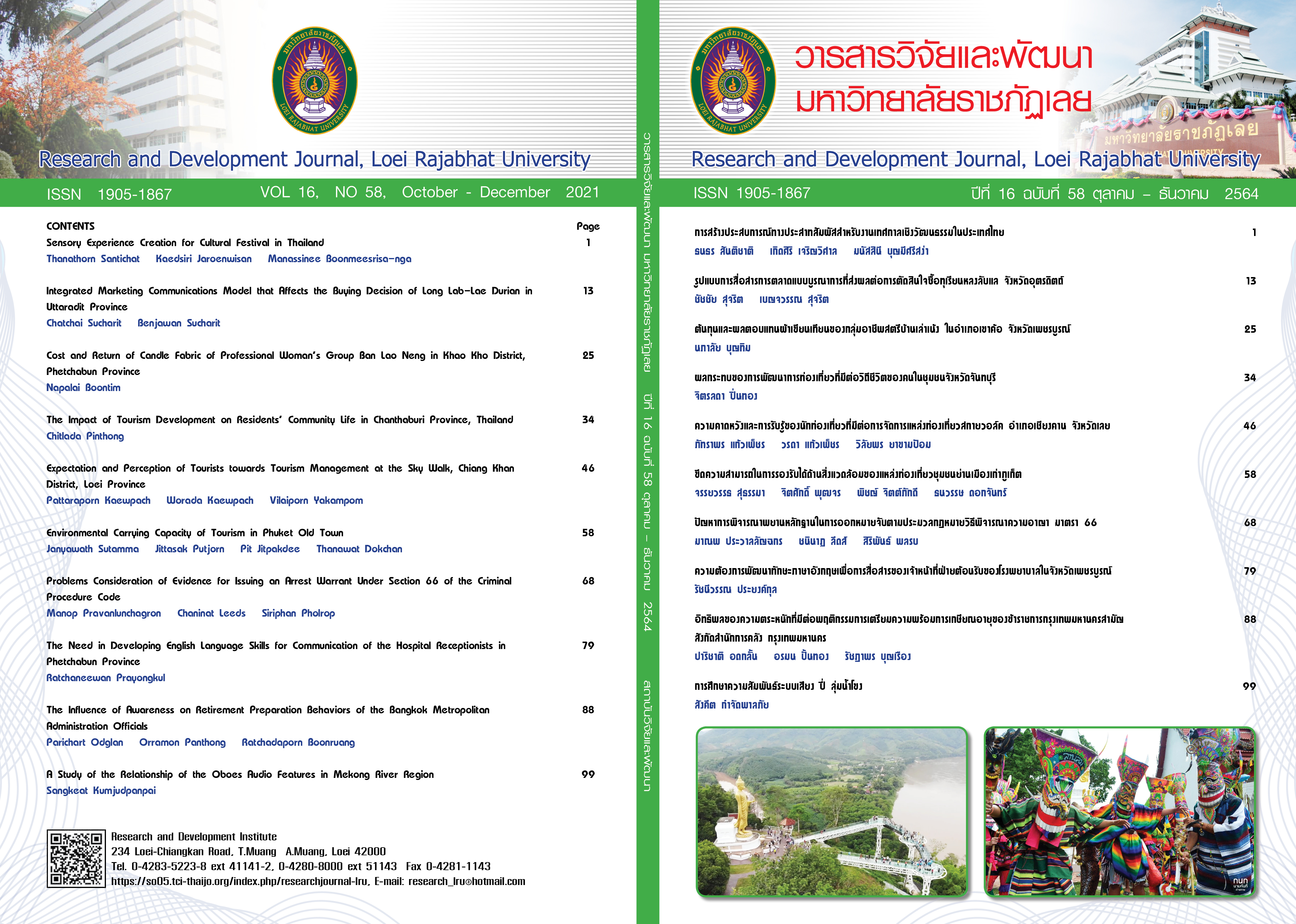Cost and Return of Candle Fabric of Professional Woman’s Group Ban Lao Neng in Khao Kho District, Phetchabun Province
Keywords:
cost, return, candle fabricAbstract
The objectives of this study were to study the manufacturing process of candle fabric and to explore the cost and return of candle fabric of professional woman’s group Ban Lao Neng in Khao Kho District, Phetchabun Province. This research was qualitative research. The research population was the group president and 12 members of the professional woman’s group Ban Lao Neng. The research instrument was a structured interview. The statistics were used descriptive statistics, percentage, cost, income, profit and loss, profit margin, payback period, and benefit-cost ratio.
The research results were as follows: the production of candle fabric was divided into 2 types of raw materials: hemp and cotton fabrics. The manufacturing process of candle fabrics were divided into 3 steps: Step 1 drew a pattern on the fabric. Step 2 dyeing the fabric. Step 3 peeling the candle. The average cost of candle fabric production per month divided into hemp fabric has a total cost of 58,465 baht, due to direct raw materials cost 48,750 baht or 83.38% of the total cost and cost per piece 3,898 baht. The total cost of cotton was 13,465 baht, most of which was the labor cost for drawing patterns 8,925 baht or 66.28% of the total cost and cost per piece 898 baht.
Candle fabric return analysis consists of profit from candle fabric sales per month was divided into hemp fabric is 2,352 baht and cotton is 1,510 baht. Profit margin analysis of hemp fabric was 37.63% and cotton was 25.17%. Payback period of cotton 3 months and hemp fabric 10 months. The benefit–cost ratio of hemp fabric was 1.60 and cotton was 1.34, which showed that the manufacturing quick payback. Therefore, candle fabrics were products of the community that has very worth the investment.
References
แก้วมณี อุทิรัมย์ และคณะ. (2560). การวิเคราะห์ต้นทุนและผลตอบแทนจากการทอผ้าไหมมัดหมี่ตีนแดง ตำบลนาโพธิ์ อำเภอนาโพธิ์ จังหวัดบุรีรัมย์. วารสารวิจัยและพัฒนา มหาวิทยาลัยราชภัฏบุรีรัมย์, 12(2), 116-124.
ทศพล ไชยประคอง, และปฐมชัย กรเลิศ. (2561). การศึกษาและวิเคราะห์ต้นทุน ปริมาณ และกำไรของผลิตภัณฑ์ผ้าฝ้ายทอมือ: กรณีศึกษาหมู่บ้านหนองอาบช้าง ตำบลสบเตี๊ยะ อำเภอจอมทอง จังหวัดเชียงใหม่. วารสารมหาวิทยาลัย พายัพ, 28(1), 71-83.
ปกฤษณา กองวงค์. (2560, 18 กันยายน). ผ้าเขียนเทียนบาติกแห่ง “บ้านม้งดอยปุย”. สืบค้นจาก http://www.khaosod.co.th/lifestyle/new_514257.
ปิยะนุช เทือกเทพ และวรนุช นิลเขต. (2560). การศึกษาความเป็นไปได้ในการลงทุนธุรกิจ ผ้าไหม บ้านหนองช้าง อำเภอสามชัย จังหวัดกาฬสินธุ์. รายงานสืบเนื่องจากการประชุมวิชาการเสนอผลงานวิจัยระดับบัณฑิตศึกษาครั้งที่ 2 มหาวิทยาลัยราชภัฏมหาสารคาม. (น.1129-1134). การประชุมวิชาการ ประจำปี 2560. มหาวิทยาลัยราชภัฏมหาสารคาม, มหาสารคาม.
ศศิวิมล มีอำพล. (2558). การบัญชีเพื่อการจัดการ. กรุงเทพฯ: เสมาธรรม.
สำนักงานนวัตกรรมแห่งชาติ (องค์การมหาชน). (2564, 7 มกราคม). ผ้าเขียนเทียนสีธรรมชาติอัตลักษณ์ วิถีเผ่าม้ง. สืบค้นจาก http://social.nia.or.th/2021/open0021/.
อินทิรา ศิลปาจารย์, จริญญา สันฐิติธนาวัฒน์, น้ำอ้อย จันทะนาม, แพรววิภา นิลแก้ว และสุภาภรณ์ แสนทุนท้าว. (2560). โครงการวิจัยเรื่องการมีส่วนร่วมของชุมชนในการอนุรักษ์และ สืบทอดผ้าเขียนเทียนของชาวไทยเผ่าม้งในจังหวัดเชียงราย (รายงานการวิจัย). กรุงเทพฯ: กรมส่งเสริมวัฒนธรรม กระทรวงวัฒนธรรม.
องค์การบริหารส่วนตำบลโป่งแยง. (2560, 16 มิถุนายน). ผ้าเขียนเทียนศิลปะของชนเผ่าม้ง. สืบค้นจาก http://www.pongyeantravel.com/Article.php?id=126.
ผู้ให้สัมภาษณ์
นุชจรีย์ ประทีปคีรี. (2561, 5 กันยายน). ประธานกลุ่มอาชีพสตรีบ้านเล่าเน้ง ตำบลเขาค้อ อำเภอเขาค้อ จังหวัดเพชรบูรณ์. [สัมภาษณ์].
อดุลย์ ประทีปคีรี. (2562, 27 กรกฎาคม). อดีตผู้ใหญ่บ้าน บ้านเล่าเน้ง ตำบลเขาค้อ อำเภอเขาค้อ จังหวัดเพชรบูรณ์. [สัมภาษณ์].
Downloads
Published
How to Cite
Issue
Section
License
ข้อความที่ปรากฎในวารสารฉบับนี้เป็นความคิดเห็นของผู้เขียนแต่ละท่าน สถาบันวิจัยและพัฒนา มหาวิทยาลัยราชภัฏเลย และกองบรรณาธิการ ไม่จำเป็นต้องเห็นด้วยและไม่มีส่วนรับผิดชอบใดๆ
สถาบันวิจัยและพัฒนา มหาวิทยาลัยราชภัฏเลย ขอให้ผู้อ่านอ้างอิงในกรณีที่ท่านคัดลอกเนื้อหาบทความในวารสารฉบับนี้






